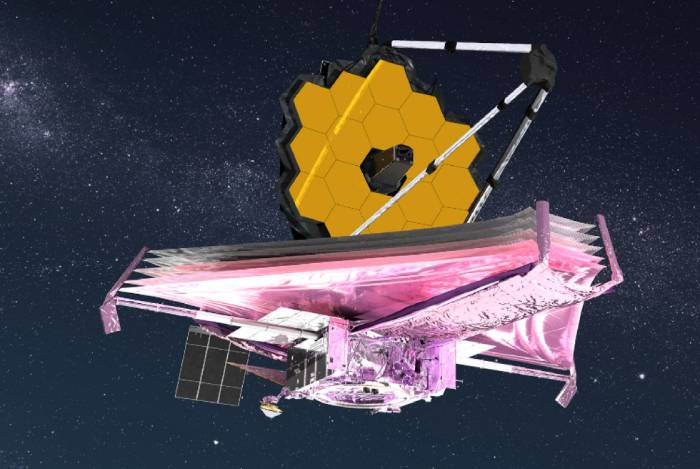The world’s most powerful space telescope is keeping its cool in orbit.
On Tuesday, the James Webb Space Telescope, which was launched on Christmas Day, successfully deployed its 70-foot (21-meter) sunshield. This is one of several crucial milestones that must be met for the NASA observatory to work correctly in space, and the Webb team is relieved to have reached it.
In a statement, Gregory L. Robinson, Webb’s programme director at NASA Headquarters, said, “Unfolding Webb’s sunshield in space is an incredible milestone, crucial to the success of the mission.” “Thousands of parts had to work with precision for this marvel of engineering to fully unfurl. The team has accomplished an audacious feat with the complexity of this deployment — one of the boldest undertakings yet for Webb .”
According to NASA, it’s one of the most challenging spacecraft deployments the agency has ever tried.
In space, Unfurling a tennis court
Webb’s large mirror and instruments will be shielded from the sun’s heat by a massive five-layer sunshield. To examine the universe as intended, the mirror and instruments must be kept at a very cold negative 370 degrees Fahrenheit (negative 188 degrees Celsius). Each of the five sheets has a reflective metal coating and is as thin as a human hair.
The sunshield on Webb was folded up to fit within the Ariane 5 rocket that took the telescope into space when it was launched. On December 28, the eight-day process of unfolding and tightening the protective shield began. This involves unfolding the shield’s support structure over several days before beginning the tensioning, or tightening, of each layer.
At 11:59 a.m. ET on Tuesday, the fifth layer of the sunshield was tightened and fastened into position.
Hundreds of release mechanisms, hinges, deployment motors, pulleys, and cables were all perfectly coordinated during the entire procedure, which was overseen by staff on Earth.
“The membrane tensioning phase of sunshield deployment is especially challenging because there are complex interactions between the structures, the tensioning mechanisms, the cables and the membranes,” said James Cooper, NASA’s Webb sunshield manager, headquartered at Goddard Space Flight Center. “This was the hardest part to test on the ground, so it feels awesome to have everything go so well today.”
The teams have been working 12-hour shifts to guarantee that Webb’s deployments go off without a hitch.
With the sunshield in place, Webb’s project manager Bill Ochs estimates that the telescope has avoided 70 percent to 75 percent of the more than 300 single-point failures that could have hampered its function.
In a statement, Jim Flynn, sunshield manager at Northrop Grumman, NASA’s primary contractor for Webb, said, “This milestone represents the pioneering spirit of thousands of engineers, scientists, and technicians who spent significant portions of their careers developing, designing, manufacturing, and testing this first-of-its kind space technology.”
The telescope can view back in time, revealing previously unseen aspects and peering deeper into the universe than ever before, thanks to its infrared studies.
The Webb telescope will study every stage of cosmic evolution, from the earliest glimmers after the Big Bang that created our universe through the birth of the galaxies, stars, and planets that populate it today. The observatory’s capabilities will allow it to see inside exoplanet atmospheres and analyse faint signals from the primordial galaxies that formed 13.5 billion years ago.
In a statement, Thomas Zurbuchen, associate administrator for NASA’s Science Mission Directorate, said, “This is the first time anyone has ever attempted to put a telescope this large into space.” “Webb required not only careful assembly but also careful deployments. The success of its most challenging deployment — the sunshield — is an incredible testament to the human ingenuity and engineering skill that will enable Webb to accomplish its science goals.”
What will happen next?
Webb is projected to reach its target orbit a million miles from Earth in approximately 29 days, with additional key stages along the road, including another major obstacle later this week: unfolding the telescope’s mirror.
The mirror may stretch to a gigantic length of 21 feet and 4 inches (6.5 metres), allowing it to catch more light from objects once the telescope is in space. The more light collected by the mirror, the more details the telescope can see.
It’s the largest mirror NASA has ever built, but its size posed a unique challenge. The mirror was too big to fit inside a rocket. Engineers created the telescope as a set of movable pieces that can fold up like origami and fit into a 16-foot (5-meter) launch slot.
The mirror’s 18 hexagonal gold-coated segments must unfold and lock together in the following sequence of critical processes for Webb. By the end of this week, all of these tasks should be completed.
Finally, Webb will alter its trajectory yet again to place itself in an orbit that extends beyond the moon.
While that completes the 29-day countdown, the telescope will undergo a five-and-a-half-month phase of commissioning in orbit, which includes cooling down, aligning, and calibrating its equipment. All of the instruments will also undergo a checkup to ensure that they are in good working order.
Later in 2022, Webb will begin collecting data and producing its first photos, which will be revealed in June or July 2023, forever transforming the way people see and understand the universe.
- Google Doodle Celebrates King’s Day (Koningsdag) 2025 - April 26, 2025
- NCAA DIII Men’s Volleyball Championship 2025: Full Bracket, Schedule, and Scores - April 26, 2025
- NCAA DII Men’s Golf 2025: See the Complete List of Regional Selections - April 26, 2025



